
Home Camera Articles FOR SALE Orders I Buy / Wants Repairs Books Adapters
Early Nikon F Tick Mark Lenses

The Nikon F was an extraordinary camera, one of the most important in 35mm History. The early F's and their lenses are especially interesting to the experienced F collector because their rare variations are different from the hundreds of thousands of F cameras and lenses that would follow -- making them a collector's delight.
The earliest Nikon F lenses are the four very rare TICK Mark lenses: the 3.5cm/2.8, 5cm/2, 10.5cm/2.5, and 13.5 cm/3.5. Remember the F was Nikon's first SLR -- Nikon was in a learning curve on the early F cameras and lenses. TICK Mark lenses get their name from the fine calibration Marks on the aperture rings, precisely indicating the Marked f/stop. This kind of calibration made sense if the aperture ring has no click stops, but its superfluous with click stopped lenses. As a result, TICK Mark lenses were soon discontinued, creating a rarity for the intent Nikon F collector. To a knowledgeable collector, the earlier the TICK lens, the better -- just like the early F bodies.
TICK Mark lenses have a Combination of Unique Features
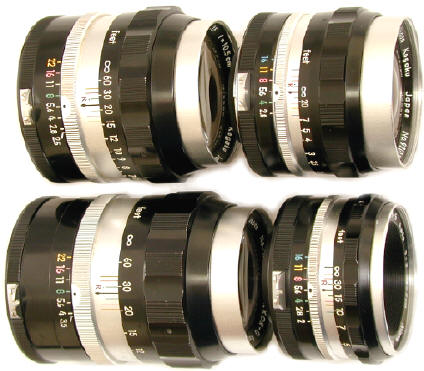
TICK Mark Lens Production
TICK Mark Production figures has long been a problem to Nikon F Collectors, and still is. If you have a TICK Mark lens, please email me with the serial number and details of your lens. Many details are still not known. Information on this page will change as better information comes to light. While I helped fill in a few blanks, most of the production figure research was done by Swiss Nikon Collector Richard de Stoutz.

3.5/2.8 TICK Mark 600 Production ?? The 3.5/2.8 seems to be the most enigmatic and inconsistent of the TICK Mark lenses. Starting number believed to be 920101. Lenses 920429, 920518, 920701 and 921170 are TICK marked. Lenses 920511, 920560, 920704, 920782, 920894 and 920982 have NO TICK marks. 3.5 TICK mark is was not continuous, for whatever reason. Perhaps the idea that the TICK marks were not needed was first tried on the 3.5 cm ?? Shown above is lens number 920127, the 27th Nikkor 35 in F mount. The color coded TICK Marks, red R for IR film, color coded Depth of Field scale, focusing scale in Feet only, are all easily visible.
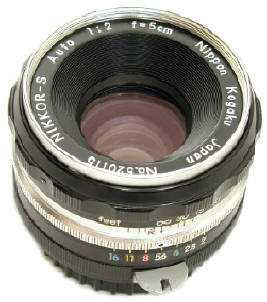
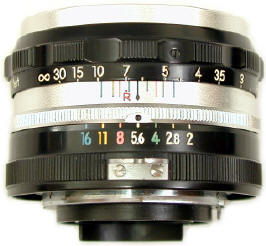
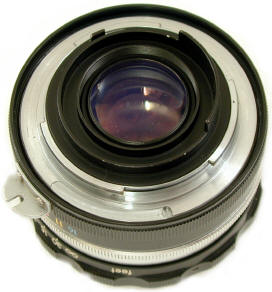
5.0/2 TICK Mark 5500 Production ? Starting number is believed to be 520101. Shown above is lens number 520115, the 15th Nikkor normal lens in F mount. Production was apparently not continuous. Lens number 525089, 525458 and 525641 are TICK marked, 525293 is not. The cutout in the solid chrome rear mount is shown extending from near the meter coupling prong to the recess just to the right of center in the photo.
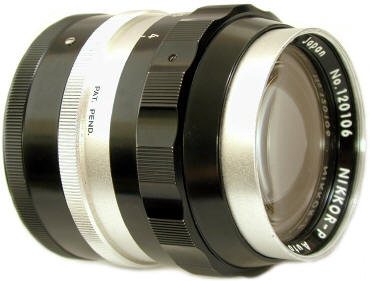
10.5/2.5 TICK Mark Production 1000? Starting number believed to be 120102, ending production somewhere between 121034 and 121118, assuming TICK mark production was contiguous. Shown above is number 120106, the 5th Nikkor 105 in F mount. The "PAT. PEND." engraving is clearly seen here. Unlike the other TICK Mark lenses pictured here, this 105 as well as the other early 105 # 120261 I've seen, both have Amber colored coating, rather than deep blue.

13.5/3.5 TICK Mark Production 1100? Starting number believed to be 720101, ending production somewhere between 721026 and 721215, assuming TICK mark production was contiguous. Shown above is number 720125, the 25th Nikkor 135 in F mount.
Starting serial numbers listed above for the 5.0, 10.5, and 13.5 cm lenses are those listed in Peter Braczko's excellent "Nikon Pocket Book." Oddly, he does not give a starting serial number for the 3.5cm. It is quite a reasonable guess, however, since the other three starting lens numbers end in at 101 or 102, that the starting 3.5's last three digits are 101 -- especially since number 107 has been reported. Richard de Stoutz has a logical theory that all four starting TICK lens numbering sequences used "101" as the last 3 digits ... but then that would assume the numbering sequence was logical. Until more info turns up, the numbers reported by Braczko will be used by me.
Very Early literature shows a TICK Marked 2.8/3.5. Whether 28 TICK Marks were prototypes or extremely early production is presently unknown. The 2.8/3.5 starting serial number is 301111. Early lenses 301169 and 301180 have no TICK marks, no red R, have "PATS. PEND." instead of "PAT. PEND, " and have the later style dual focusing scale marked in feet and meters. IF 28 TICK lenses turn up, they would become the rarest of the TICK Mark series.
ALL TICK Marked lenses ARE NOT THE SAME: Variations exist even within the first several hundred lenses. For instance the filter ring engravings are noticeably heavier on 10.5/2.5 # 120106 compared to # 120261. The early 3.5, 5.0, and 13.5 lenses have a deep blue lens coating. At least the earlier 10.5's have an amber lens coating. There may have been a few transitional lenses to the new plain type of aperture ring before the TICK Marks were discontinued, or a few TICK lenses may have had replacement aperture rings during their lives, in any case a very few new type aperture rings are mixed into the TICK lens numbers. An interesting variation is 20cm-60cm zoom number 170343, which has a TICK marked focusing scale, but no TICK marks on the aperture ring. Likewise 8.5cm-25cm zoom number 158079 has a TICK marked focusing scale, but no TICK marks on the aperture ring.
TICK Mark Lenses established the "Nikkor F Lens Style": As the first Nikon F lenses, TICK Mark lenses established what became the standard Nikkor F Lens Style for many years to come:
- Nikon F bayonet mount: the bayonet itself continues to this day
- Click stopped f/stops: continues to this day
- Auto internal spring activated diaphragm for most lenses: continues to this day
- Coated Lenses: continues with improvements to this day
- Color Coded f/stops: continued to end of MF lenses
- Color Coded Depth of Field Scale corresponding to the color coded F/stops: continued to end of MF lenses
- Black Metal aperture ring: continued until end of MF lenses.
- Chrome Middle ring next to aperture ring: continued in MF Nikkors until AF Nikkors
- 52mm filter size established as standard Nikon F filter size for most lenses from 20mm to 200mm: continued until AF Nikkors, which use 62mm as a standard filter size when possible.
- Scalloped Black metal focusing ring: started to be replaced by rubber focusing grip on the most popular lenses in 1974
- Lens Element Number coded by letter on filter ring: started to be omitted when rubber focusing grips replaced metal focusing barrels on the most popular lenses in 1974
- Prong style meter coupling (originally coupling to the selenium clip on meter, later coupling to the various Nikon bodies): continued as the only meter coupling until the introduction of AI lenses in 1977. AI lenses offered both the metering prong coupling, and a coupling ledge at the rear of the lens which automatically mated with the camera's meter. Nikon offered AI modification for many of the older lenses, replacing the old aperture ring with a new one that had the AI meter coupling and double row of F/stops for the finder aperture readouts. IF no Nikon AI lens was offered for a particular lens serial number range, or after Nikon ran out of the AI rings, many repairmen modified older lenses by machining the AI coupling into the rear of the lens. Even today, the meter prong can be added to most AF Nikkors to make them backwardly compatible.
- Focal Length Marked in Centimeters (CM): continued to middle 1960's. The CM focal length engraving by itself is not particularly noteworthy.
- Chrome Filter ring lens barrel: continued to late 1960's.
- "Nippon Kogaku Japan" filter ring engraving: continued till late 1960's The NKJ engraving by itself is not particularly noteworthy.
To make Nikon lens classifications even more confusing, most of the various characteristics changed at different times, on different lenses. It must be emphasized that Nikkor lens characteristics seldom changed in unison over the entire, very large lens range. Style changes generally appeared in the most popular focal lengths and f/stops first. Style changes for low production lenses were often adopted over time as parts ran out, and as lenses needed major optical and structural updates. Contemporary lenses of different focal lengths and f/stops often have slightly different family features. With Nikon's large lens line from 6mm to 2000mm, the variety in these small details often defies attempts of organized lens classification. Once a change was made, a particular feature usually continued until all the older parts were used up ... older parts for one lens could be used up long before the parts of another lens, playing havoc with attempts at lens classification.
With the largest 35mm lens lineup, Nikon lenses have great variety. ALL lenses did not have ALL of the "standard" Nikkor features listed above. For instance, mirror lenses with their fixed apertures, did not have meter coupling rings, click stopped f/stops, or automatic diaphragms.
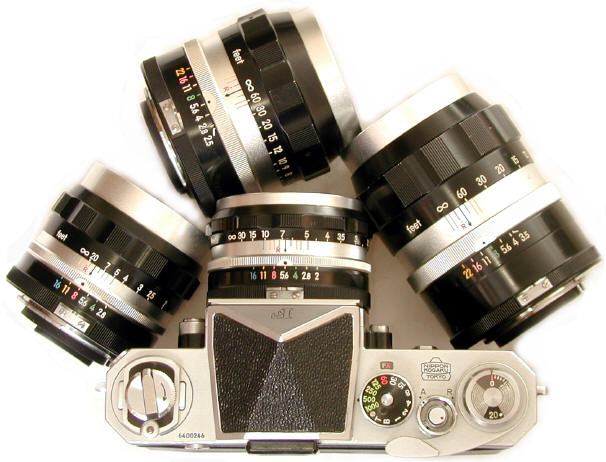
Early Nikon F Tick Mark Collection: the 246th Nikon F with the 27th Nikkor 35/2.8, the 15th Nikkor 50/2, the 6th Nikkor 105, and the 25th Nikkor 135.
If you are a serious Nikon collector and have not already heard of TICK Mark lenses, let me explain that no standard Nikon reference book I've seen (in English) mentions them by name. For example, the Nikon Compendium's mediocre Nikon F lens classification system doesn't seem to have a clue that TICK Mark lenses even exist. The only previously published detailed English language source I'm aware of are several articles in the high quality, but not widely distributed, Journal of the Nikon Historical Society. The first article NHS TICK article was written by Calvin Ho, who probably invented the "TICK" designation. While experienced collectors went about intently searching for TICK Marked lenses, the inexperienced sold them for a small fraction of their value without knowing what they had -- a standard scenario for all collectibles.
Again, my thanks to Richard de Stoutz, Yasuyuki Ochiai, and Roland Vink for sharing information.
Revised: February 19, 2004 . Copyright � 1998-2004 Stephen Gandy. All rights reserved. This means you may NOT copy and re-use the text or the pictures in ANY other internet or printed publication of ANY kind. Information in this document is subject to change without notice. Other products and companies referred to herein are trademarks or registered trademarks of their respective companies or mark holders.